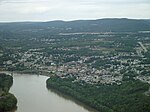Duryea Yard
1870 establishments in PennsylvaniaPittston, PennsylvaniaRail yards in PennsylvaniaTransportation buildings and structures in Luzerne County, PennsylvaniaUse mdy dates from December 2022

Duryea Yard (formerly Coxton Yard, sometimes Pittston Junction, or West Pittston Yard) is a railroad yard in the Wyoming Valley region of Northeastern Pennsylvania currently operated by the Reading Blue Mountain and Northern Railroad. Originally constructed in 1870 by Lehigh Valley Railroad as a turn-around and staging hub for coal transport from the Coal Region to Eastern big-city markets, the yard remains a hub for the energy extraction industry today (as of 2017).
Excerpt from the Wikipedia article Duryea Yard (License: CC BY-SA 3.0, Authors, Images).Duryea Yard
North Main Street,
Geographical coordinates (GPS) Address Nearby Places Show on map
Geographical coordinates (GPS)
| Latitude | Longitude |
|---|---|
| N 41.343 ° | E -75.786433 ° |
Address
North Main Street
North Main Street
18642
Pennsylvania, United States
Open on Google Maps








